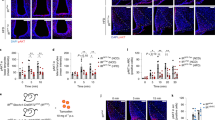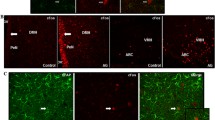Abstract
Our group previously reported that 6-h fasting increased both insulin II mRNA expression and insulin level in rat hypothalamus. Given that insulin effects on central glucose metabolism are insufficiently understood, we wanted to examine if the centrally produced insulin affects expression and/or regional distribution of glucose transporters, and glycogen stores in the hypothalamus during short-term fasting. In addition to determining the amount of total and activated insulin receptor, glucose transporters, and glycogen, we also studied distribution of insulin receptors and glucose transporters within the hypothalamus. We found that short-term fasting did not affect the astrocytic 45 kDa GLUT1 isoform, but it significantly increased the amount of endothelial 55 kDa GLUT1, and neuronal GLUT3 in the membrane fractions of hypothalamic proteins. The level of GLUT2 whose presence was detected in neurons, ependymocytes and tanycytes was also elevated. Unlike hepatic glycogen which was decreased, hypothalamic glycogen content was not changed after 6-h fasting. Our findings suggest that neurons may be given a priority over astrocytes in terms of glucose supply even during the initial phase of metabolic response to fasting. Namely, increase in glucose influx into the brain extracellular fluid and neurons by increasing the translocation of GLUT1, and GLUT3 in the cell membrane may represent the first line of defense in times of scarcity. The absence of co-localization of these membrane transporters with the activated insulin receptor suggests this process takes place in an insulin-independent manner.







Similar content being viewed by others
References
Mergenthaler P, Lindauer U, Dienel GA, Meisel A (2013) Sugar for the brain: the role of glucose in physiological and pathological brain function. Trends Neurosci 36:587–597. https://doi.org/10.1016/j.tins.2013.07.001
Sivitz W, DeSautel S, Walker PS, Pessin JE (1989) Regulation of the glucose transporter in developing rat brain. Endocrinology 124:1875–1880. https://doi.org/10.1210/endo-124-4-1875
Maher F, Vannucci SJ, Simpson IA (1993) Glucose transporter isoforms in brain: absence of GLUT3 from the blood–brain barrier. J Cereb Blood Flow Metab 13:342–345. https://doi.org/10.1038/jcbfm.1993.43
Vannucci SJ, Koehler-Stec EM, Li K, Reynolds TH, Clark R, Simpson IA (1998) GLUT4 glucose transporter expression in rodent brain: effect of diabetes. Brain Res 797:1–11. https://doi.org/10.1016/S0006-8993(98)00103-6
Choeiri C, Staines W, Messier C (2002) Immunohistochemical localization and quantification of glucose transporters in the mouse brain. Neuroscience 111:19–34. https://doi.org/10.1016/S0306-4522(01)00619-4
Nagamatsu S, Sawa H, Kamada K, Nakamichi Y, Yoshimoto K, Hoshino T (1993) Neuron-specific glucose transporter (NSGT): CNS distribution of GLUT3 rat glucose transporter (RGT3) in rat central neurons. FEBS Lett 334:289–295. https://doi.org/10.1016/0014-5793(93)80697-S
Gómez O, Ballester-Lurbe B, Poch E, Mesonero JE, Terrado J (2010) Developmental regulation of glucose transporters GLUT3, GLUT4 and GLUT8 in the mouse cerebellar cortex. J Anat 217:616–623. https://doi.org/10.1111/j.1469-7580.2010.01291.x
Maher F, Davies-Hill TM, Lysko PG, Henneberry RC, Simpson IA (1991) Expression of two glucose transporters, GLUT1 and GLUT3, in cultured cerebellar neurons: evidence for neuron-specific expression of GLUT3. Mol Cell Neurosci 2:351–360. https://doi.org/10.1016/1044-7431(91)90066-W
Simpson I, Carruthers A, Vannucci SJ (2007) Supply and demand in cerebral energy metabolism: the role of nutrient transporters. J Cereb Blood Flow Metab 27:1766–1791. https://doi.org/10.1038/sj.jcbfm.9600521
Simpson IA, Dwyer D, Malide D, Moley KH, Travis A, Vannucci SJ (2008) The facilitative glucose transporter GLUT3: 20 years of distinction. AJP Endocrinol Metab 295:E242–E253. https://doi.org/10.1152/ajpendo.90388.2008
Leloup C, Arluison M, Lepetit N, Cartier N, Marfaing-Jallat P, Ferré P et al (1994) Glucose transporter 2 (GLUT 2): expression in specific brain nuclei. Brain Res 638:221–226. https://doi.org/10.1016/0006-8993(94)90653-X
Penicaud L, Leloup C, Lorsignol A, Alquier T, Guillod E (2002) Brain glucose sensing mechanism and glucose homeostasis. Curr Opin Clin Nutr Metab Care 5:539–543
De los Angeles García M, Millán C, Balmaceda-Aguilera C, Castro T, Pastor P, Montecinos HH et al (2003) Hypothalamic ependymal-glial cells express the glucose transporter GLUT2, a protein involved in glucose sensing. J Neurochem 86:709–724. https://doi.org/10.1046/j.1471-4159.2003.01892.x
Koekkoek LL, Mul JD, la Fleur SE (2017) Glucose-sensing in the reward system. Front Neurosci. https://doi.org/10.3389/fnins.2017.00716
Kobayashi M, Nikami H, Morimatsu M, Saito M (1996) Expression and localization of insulin-regulatable glucose transporter (GLUT4) in rat brain. Neurosci Lett 213:103–106. https://doi.org/10.1016/0304-3940(96)12845-7
Duelli R, Kuschinsky W (2001) Brain glucose transporters: relationship to local energy demand. News Physiol Sci 16:0–5
Pellerin L, Magistretti PJ (1994) Glutamate uptake into astrocytes stimulates aerobic glycolysis: a mechanism coupling neuronal activity to glucose utilization. Proc Natl Acad Sci 91:10625–10629. https://doi.org/10.1073/pnas.91.22.10625
McCall AL (2004) Cerebral glucose metabolism in diabetes mellitus. Eur J Pharmacol. https://doi.org/10.1016/j.ejphar.2004.02.052
Bélanger M, Allaman I, Magistretti PJ (2011) Brain energy metabolism: focus on astrocyte-neuron metabolic cooperation. Cell Metab. https://doi.org/10.1016/j.cmet.2011.08.016
Barros LF, Deitmer JW (2010) Glucose and lactate supply to the synapse. Brain Res Rev. https://doi.org/10.1016/j.brainresrev.2009.10.002
Lundgaard I, Li B, Xie L, Kang H, Sanggaard S, Haswell JDR et al (2015) Direct neuronal glucose uptake heralds activity-dependent increases in cerebral metabolism. Nat Commun. https://doi.org/10.1038/ncomms7807
Díaz-García CM, Mongeon R, Lahmann C, Koveal D, Zucker H, Yellen G (2017) Neuronal stimulation triggers neuronal glycolysis and not lactate uptake. Cell Metab. https://doi.org/10.1016/j.cmet.2017.06.021
Inoue N, Matsukado Y, Goto S, Miyamoto E (1988) Localization of glycogen synthase in brain. J Neurochem 50:400–405. https://doi.org/10.1111/j.1471-4159.1988.tb02926.x
Saez I, Duran J, Sinadinos C, Beltran A, Yanes O, Tevy MF et al (2014) Neurons have an active glycogen metabolism that contributes to tolerance to hypoxia. J Cereb Blood Flow Metab 34:945–955. https://doi.org/10.1038/jcbfm.2014.33
Vilchez D, Ros S, Cifuentes D, Pujadas L, Vallès J, García-Fojeda B et al (2007) Mechanism suppressing glycogen synthesis in neurons and its demise in progressive myoclonus epilepsy. Nat Neurosci 10:1407–1413. https://doi.org/10.1038/nn1998
Drulis-Fajdasz D, Gizak A, Wójtowicz T, Wiśniewski JR, Rakus D (2018) Aging-associated changes in hippocampal glycogen metabolism in mice. Evidence for and against astrocyte-to-neuron lactate shuttle. GLIA. https://doi.org/10.1002/glia.23319
Choi IY, Seaquist ER, Gruetter R (2003) Effect of hypoglycemia on brain glycogen metabolism in vivo. J Neurosci Res 72:25–32. https://doi.org/10.1002/jnr.10574
Suh SW, Bergher JP, Anderson CM, Treadway JL, Fosgerau K, Swanson RA (2007) Astrocyte glycogen sustains neuronal activity during hypoglycemia: studies with the glycogen phosphorylase inhibitor CP-316,819 ([R-R*,S*]-5-chloro-N-[2-hydroxy-3-(methoxymethylamino)-3-oxo-1-(phenylmethyl)propyl]-1H-indole-2-carboxamide). J Pharmacol Exp Ther 321:45–50. https://doi.org/10.1124/jpet.106.115550
Matsui T, Soya S, Okamoto M, Ichitani Y, Kawanaka K, Soya H (2011) Brain glycogen decreases during prolonged exercise. J Physiol 589:3383–3393. https://doi.org/10.1113/jphysiol.2010.203570
DiNuzzo M, Mangia S, Maraviglia B, Giove F (2012) The role of astrocytic glycogen in supporting the energetics of neuronal activity. Neurochem Res. https://doi.org/10.1007/s11064-012-0802-5
Dakic TB, Jevdjovic TV, Peric MI, Bjelobaba IM, Markelic MB, Milutinovic BS et al (2017) Short-term fasting promotes insulin expression in rat hypothalamus. Eur J Neurosci 46:1730–1737. https://doi.org/10.1111/ejn.13607
Lowry OH, Rosebrough NJ, Farr AL, Randall RJ (1951) Protein measurement with the Folin–Phenol reagent. J Biol Chem 193:265–275. https://doi.org/10.1016/0304-3894(92)87011-4
Rasouli M, Shokri-Afra H, Ostovar-Ravari A (2015) A new protocol for separation of acid soluble and insoluble fractions from total glycogen and simultaneous measurements. Eur Rev Med Pharmacol Sci 19:1785–1789
Rasouli M, Ostovar-Ravari A, Shokri-Afra H (2014) Characterization and improvement of phenol-sulfuric acid microassay for glucose-based glycogen. Eur Rev Med Pharmacol Sci 18:2020–2024
Mitrakou A, Ryan C, Veneman T, Mokan M, Jenssen T, Kiss I et al (1991) Hierarchy of glycemic thresholds for counterregulatory hormone secretion, symptoms, and cerebral dysfunction. Am J Physiol 260:E67–E74. https://doi.org/10.1152/ajpendo.1991.260.1.E67
Giudice J, Barcos LS, Guaimas FF, Penas-Steinhardt A, Giordano L, Jares-Erijman E et al (2013) Insulin and insulin like growth factor II endocytosis and signaling via insulin receptor B. Cell Commun Signal 11:18. https://doi.org/10.1186/1478-811X-11-18
Marks JL, Porte D, Stahl WL, Baskin DG (1990) Localization of insulin receptor mRNA in rat brain by in situ hybridization. Endocrinology 127:3234–3236. https://doi.org/10.1210/endo-127-6-3234
Werther GA, Hogg A, Oldfield BJ, McKinley MJ, Figdor R, Allen AM et al (1987) Localization and characterization of insulin receptors in rat brain and pituitary gland using in vitro autoradiography and computerized densitometry. Endocrinology 121:1562–1570. https://doi.org/10.1210/endo-121-4-1562
Obici S, Feng Z, Karkanias G, Baskin DG, Rossetti L (2002) Decreasing hypothalamic insulin receptors causes hyperphagia and insulin resistance in rats. Nat Neurosci 5:566–572. https://doi.org/10.1038/nn861
Unger J, McNeill TH, Moxley RT, White M, Moss A, Livingston JN (1989) Distribution of insulin receptor-like immunoreactivity in the rat forebrain. Neuroscience 31:143–157. https://doi.org/10.1016/0306-4522(89)90036-5
Gray SM, Meijer RI, Barrett EJ (2014) Insulin regulates brain function, but how does it get there? Diabetes. https://doi.org/10.2337/db14-0340
Ghasemi R, Haeri A, Dargahi L, Mohamed Z, Ahmadiani A (2013) Insulin in the brain: sources, localization and functions. Mol Neurobiol. https://doi.org/10.1007/s12035-012-8339-9
Furtado LM, Somwar R, Sweeney G, Niu W, Klip A (2002) Activation of the glucose transporter GLUT4 by insulin. Biochem Cell Biol 80:569–578. https://doi.org/10.1139/o02-156
Richter E, Hargreaves M, Exercise (2013) GLUT4, and skeletal muscle glucose uptake. Physiol Rev 93:993–1017. https://doi.org/10.1152/physrev.00038.2012
Clarke DW, Boyd FT, Kappy MS, Raizada K (1984) Insulin binds to specific receptors and stimulates 2-deoxy-D-glucose uptake in cultured glial cells from rat brain. J Biol Chem 259:11672–11675
McAllister MS, Krizanac-Bengez L, Macchia F, Naftalin RJ, Pedley KC, Mayberg MR et al (2001) Mechanisms of glucose transport at the blood-brain barrier: an in vitro study. Brain Res 904:20–30. https://doi.org/10.1016/S0006-8993(01)02418-0
Ngarmukos C, Baur EL, Kumagai AK (2001) Co-localization of GLUT1 and GLUT4 in the blood-brain barrier of the rat ventromedial hypothalamus. Brain Res 900:1–8. https://doi.org/10.1016/S0006-8993(01)02184-9
Simpson IA, Appel NM, Hokari M, Oki J, Holman GD, Maher F et al (1999) Blood-brain barrier glucose transporter: effects of hypo- and hyper-glycemia revisited. J Neurochem 72:238–247. https://doi.org/10.1046/j.1471-4159.1999.0720238.x
Silva-Alvarez C, Carrasco M, Balmaceda-Aguilera C, Pastor P, García MDLA, Reinicke K et al (2005) Ependymal cell differentiation and GLUT1 expression is a synchronous process in the ventricular wall. Neurochem Res 30:1227–1236. https://doi.org/10.1007/s11064-005-8794-z
Garcia MA, Carrasco M, Godoy A, Reinicke K, Montecinos VP, Aguayo LG et al (2001) Elevated expression of glucose transporter-1 in hypothalamic ependymal cells not involved in the formation of the brain-cerebrospinal fluid barrier. J Cell Biochem 80:491–503
Benarroch EE (2014) Brain glucose transporters: Implications for neurologic disease. Neurology 82:1374–1379. https://doi.org/10.1212/WNL.0000000000000328
Hara M, Matsuda Y, Hirai K, Okumura N, Nakagawa H (1989) Effect of glucose starvation on glucose transport in neuronal cells in primary culture from rat brain. J Neurochem 52:909–912
Liu XH, Morris R, Spiller D, White M, Williams G (2001) Orexin a preferentially excites glucose-sensitive neurons in the lateral hypothalamus of the rat in vitro. Diabetes. https://doi.org/10.2337/diabetes.50.11.2431
Brown AM, Ransom BR (2007) Astrocyte glycogen and brain energy metabolism. GLIA. https://doi.org/10.1002/glia.20557
Rui L (2014) Energy metabolism in the liver. Compr Physiol 4:177–197. https://doi.org/10.1002/cphy.c130024
Cohen P, Nimmo HG, Proud CG (1978) How does insulin stimulate glycogen synthesis? Biochem Soc Symp 43:69–95
Vujovic P, Lakic I, Laketa D, Jasnic N, Djurasevic SF, Cvijic G et al (2011) Time-dependent effects of starvation on serum, pituitary and hypothalamic leptin levels in rats. Physiol Res 60(Suppl 1):S165–S170
Garriga J, Cussó R (1992) Effect of starvation on glycogen and glucose metabolism in different areas of the rat brain. Brain Res 591:277–282
Acknowledgements
The authors wish to thank Michael A. Chirillo MD/PhD (Department of Internal Medicine, The University of Utah School of Medicine, Salt Lake City, Utah, USA) for his help with editing and proofreading and Marko Miler PhD (Department of Cytology, Institute for Biological Research “Sinisa Stankovic”, Belgrade, Serbia) for his assistance with histological staining. This study was supported by Ministry of Education, Science and Technological Development, Republic of Serbia (173023).
Funding
This study was supported by Ministry of Education, Science and Technological Development, Republic of Serbia (173023).
Author information
Authors and Affiliations
Corresponding author
Ethics declarations
Conflict of interest
The authors declare that they have no conflict of interest.
Ethical Approval
All procedures performed in study involving animals were in accordance with the rules of the Federation of European Laboratory Animal Science and the ethical standard of the Faculty of Biology, University of Belgrade and Serbian Ministry of Agriculture, Forestry and Water Management, Veterinary Directorate.
Rights and permissions
About this article
Cite this article
Dakic, T., Jevdjovic, T., Lakic, I. et al. Food For Thought: Short-Term Fasting Upregulates Glucose Transporters in Neurons and Endothelial Cells, But Not in Astrocytes. Neurochem Res 44, 388–399 (2019). https://doi.org/10.1007/s11064-018-2685-6
Received:
Revised:
Accepted:
Published:
Issue Date:
DOI: https://doi.org/10.1007/s11064-018-2685-6




